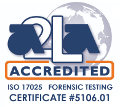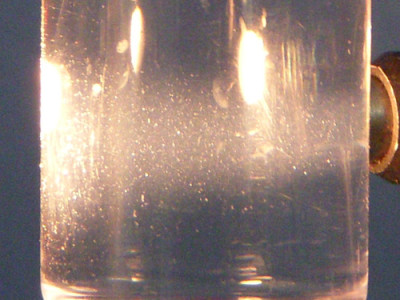Pharmaceutical Contaminant Analysis and Testing
The accurate identification of contaminant matter in the early stages of a pharmaceutical investigation can provide essential facts. Such information can help to answer critical questions, reduce risk, and save money. Microtrace scientists have been conducting foreign particle/contaminant analyses on pharmaceutical products and devices for over four decades. Over that period, we have analyzed an enormous variety of materials and compounds relevant to the pharma industry. We have tested everything from hairs, fibers, rust and stains, to excipients and precipitates of the original product material. Microtrace maintains a DEA license that permits our lab to accept and test all classes of controlled substances. Microtrace’s laboratory is also accredited to ISO/IEC 17025 by the American Association for Laboratory Accreditation (A2LA) (Certificate #5106.01).
Foreign Matter
Microtrace specializes in foreign matter identifications and assistance with sourcing investigations for the pharma industry. Our experts have the experience and expertise to locate, isolate, analyze, and identify any type of contaminant. Whether it’s a tablet, lyophilized product, drug solution, or raw material, we can help. We are not a simple service laboratory. Our expertise and familiarity with materials extends far beyond a computer generated hit list produced by a spectral search. Our expertise comes from decades of experience with a wide range of clients in both industrial and forensic capacities. We are able to provide specific identifications of virtually any material, using our vast experience in light and electron microscopy and chemical analysis via microchemistry and vibrational spectroscopy. These include, but are not limited to, hair (animal and human), fibers (synthetic and natural), polymers, metals, animal and insect parts, skin cells, and body fluids. When necessary, we conduct our work in a clean room environment to ensure that external contamination is not introduced.
Analysis of Precipitates in Solution
Microtrace can isolate, characterize, and identify even the finest precipitates observed in pharmaceutical solutions. Our experts can also identify and differentiate immiscible phases, such as silicone oils, from solids such as silica nanoparticles. In many cases, our laboratory’s high resolution analysis of particles reveals inclusions (particles within particles). This can help to explain the nucleation processes that led to particle formation.
Pharmaceutical Nanoparticle Characterization
As pharmaceuticals continue to better utilize nanoparticle technology, particle distribution and sub-micron contamination become increasingly significant. Microtrace scientists have experience analyzing, characterizing, and identifying a wide variety of nanoparticles, and have published extensively on the subject.
Glass (Pharmaceutical Vial Delamination)
Some pharmaceutical solutions are mildly or acutely corrosive to glass containers. Sample processing can hasten this process, causing delamination in the vials. The contaminant particulate matter is often very fine. As a result, these particles may require analysis by high resolution scanning electron microscopy or transmission electron microscopy. These instruments can provide morphological, size, and compositional information.
Contaminant Particle Size and Counts
Microtrace conducts microscopical measurements of particle counts, particle size, and size distribution on a wide range of samples from different environments. Our experts use both manual and automated tests. Unlike light scattering measurements, microscopy can provide information about the identity of particles and the true particle size. Such characteristics can prove especially beneficial when an investigation encounters multiple particle types.
Stain and Residue Analysis
Microtrace can isolate and identify stains on tablets, discolorations, and residues in vials, even in seemingly minute amounts. Our microanalytical methods generally allow us to consume only a minimal amount of the material in the laboratory. This ensures that residue remains in the event that the project requires future analyses.
Defect Library
Microtrace has worked with numerous pharmaceutical companies to develop customized “defect libraries” or “contaminant libraries” in which we characterize known materials from a manufacturing facility to produce a library of possible source materials for foreign particles that may be encountered. This library of analytical data may include metals, alloys, polymers, fibers, fabrics, glass, elastomers, residues, ingredients, inks, and other contaminant particles. In addition to known source materials, these libraries are also used to track contaminants. As contaminants are submitted for identification, their attributes are added to this library to produce a master list of all particles that have been encountered – at a company, at a facility, or in a product. This customizable database of materials can then be searched against new, unknown materials that are submitted. This defect library (contaminant library) is used to assist clients with identifying an unknown material, source attribution of a foreign matter (e.g., did the particle arise from a wear part, was it contributed by a supplier, or did it arise from a worker), and tracking trends in foreign material within a product or facility.
Full Service Pharmaceutical Contaminant Analysis Lab
Microtrace provides an unparalleled range of experience and analytical tools. These range from assisting clients with sample preservation, to analysis and reporting, through litigation. Our results stand up to the scrutiny of scientific review and litigation. Yet, our reports present results in a way that both consumer affairs professionals and consumers can understand.
Project Submissions
Microtrace has been providing rigorous and scientifically-supported testing of pharmaceutical contaminants for more than 25 years. Our vast experience with a large variety of materials has given us a unique and expert perspective to aid our pharmaceutical contaminant analysis. Our experts conduct all work in our custom-built, state-of-the-art ISO 17025 accredited laboratory.
Microtrace specializes in unusual cases. We recognize that every pharma investigation has its own sampling conditions and parameters. Because of this, our lab has developed the capabilities and expertise to accept a wide-variety of materials for testing and analysis.
Our laboratory’s standard pharmaceutical contaminant analysis turn-around-time is 7-10 business days. However, Rush (2-3 days) and Ultra-Rush (same-day) options are also available.
Please contact us to discuss the specific needs of your project. Microtrace holds a DEA license for all classes of controlled substances; we can assist with the 222 Form, if necessary. We also ask that a completed project submission form accompany all pharmaceutical submissions.
Related Standardized Methods
ASTM Standard(s): E1298
How May We Help You?
Contact usto discuss your project in more detail.








